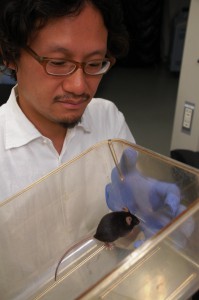
Kansai Medical University researcher Ko Kobayakawa experiments a smell of fear with a mouse in Hirakata, Osaka Prefecture
A researcher of Kansai Medical University in Hirakata, Osaka Prefecture, has discovered smells that terrify mice by acting on their brain circuit to cause an inherent sense of fear. Mice do not get accustomed to the smells even if they are repeatedly exposed to them. If the findings can be applied to other animals such as deer and wild boars, it could be used as breakthrough odor repellents for protecting crops from wildlife damage.
Ko Kobayakawa found out that animals’ ability to detect predators through smells is not learned but genetically hardwired into their brain. He identified some 30 types of smell created from synthetic substances that strongly activate the particular brain circuits.
Kobayakawa patented as an animal repellent a thiazoline type compound which he identified as one of the major “smells of fear” that animals instinctively avoid. The substance is said to smell like roasted beans and humans generally do not find the smell unpleasant.
By analyzing the behavior, brain reactions and stress hormones in the blood of mice which smelled the substance, Kobayakawa confirmed that the mice are experiencing innate fear. The substance can create ten times as much fear in the mice compared with the natural smell of cats or fox, and their reactions remained strong even after they were repeatedly made to smell the substance.
“Since it is not easy to override this feeling of fear, (the substance) has a strong repellent effect,” Kobayakawa said. He also confirmed a certain level of repellent effect in rabbits, deer and pigs. In order to market the substance as a repellent, a product with a lasting smell is currently being developed for use at households and restaurants.
(July 31, 2015)

